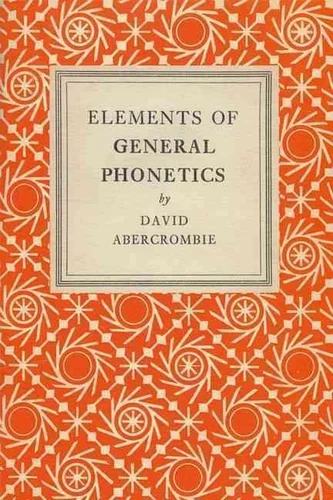Elements of General Phonetics
Par :Formats :
- Paiement en ligne :
- Livraison à domicile ou en point Mondial Relay indisponible
- Retrait Click and Collect en magasin gratuit
- Nombre de pages203
- PrésentationBroché
- FormatGrand Format
- Poids0.275 kg
- Dimensions13,8 cm × 21,5 cm × 1,2 cm
- ISBN0-85224-451-7
- EAN9780852244517
- Date de parution01/07/2001
- ÉditeurEdinburgh University Press
Résumé
Phonetics forms an exceptionally important branch of language study, since it is ultimately the basis on which all other language mediums are constructed. This book is intended primarily as a textbook for students of such subjects as linguistics, speech therapy, modern languages, and communications engineering. No previous knowledge of phonetics is assumed, and the presentation is as simple as possible, with the minimum use of diagrams and exotic symbols.
The English language is used as the source of a great part of the illustrative material, sincethe book is written in English, but the topic is, nevertheless, general phonetics, and the book will serve as a basis for further study in the phonetics of any particular language. The first chapter provides a general background to the subject and places it in the whole field of linguistic studies. Subsequent sections give a survey of the full range of human language sounds and an explanation of the techniques by which the pronunciation of any language or dialect can be described in detail.
The topics discussed are : the nature of the vocal organs and their use for the production of speech ; the analysis of speech into units suitable for description ; the division of segments into vowels and consonants ; the ways in which particular languages organize vowels and consonants into language-bearing patterns ; the roles in speech of such features as voice quality, rhythm, intonation ; and finally the purpose and varieties of phonetic notation.
A full bibliography and index complete this important book.
The English language is used as the source of a great part of the illustrative material, sincethe book is written in English, but the topic is, nevertheless, general phonetics, and the book will serve as a basis for further study in the phonetics of any particular language. The first chapter provides a general background to the subject and places it in the whole field of linguistic studies. Subsequent sections give a survey of the full range of human language sounds and an explanation of the techniques by which the pronunciation of any language or dialect can be described in detail.
The topics discussed are : the nature of the vocal organs and their use for the production of speech ; the analysis of speech into units suitable for description ; the division of segments into vowels and consonants ; the ways in which particular languages organize vowels and consonants into language-bearing patterns ; the roles in speech of such features as voice quality, rhythm, intonation ; and finally the purpose and varieties of phonetic notation.
A full bibliography and index complete this important book.
Phonetics forms an exceptionally important branch of language study, since it is ultimately the basis on which all other language mediums are constructed. This book is intended primarily as a textbook for students of such subjects as linguistics, speech therapy, modern languages, and communications engineering. No previous knowledge of phonetics is assumed, and the presentation is as simple as possible, with the minimum use of diagrams and exotic symbols.
The English language is used as the source of a great part of the illustrative material, sincethe book is written in English, but the topic is, nevertheless, general phonetics, and the book will serve as a basis for further study in the phonetics of any particular language. The first chapter provides a general background to the subject and places it in the whole field of linguistic studies. Subsequent sections give a survey of the full range of human language sounds and an explanation of the techniques by which the pronunciation of any language or dialect can be described in detail.
The topics discussed are : the nature of the vocal organs and their use for the production of speech ; the analysis of speech into units suitable for description ; the division of segments into vowels and consonants ; the ways in which particular languages organize vowels and consonants into language-bearing patterns ; the roles in speech of such features as voice quality, rhythm, intonation ; and finally the purpose and varieties of phonetic notation.
A full bibliography and index complete this important book.
The English language is used as the source of a great part of the illustrative material, sincethe book is written in English, but the topic is, nevertheless, general phonetics, and the book will serve as a basis for further study in the phonetics of any particular language. The first chapter provides a general background to the subject and places it in the whole field of linguistic studies. Subsequent sections give a survey of the full range of human language sounds and an explanation of the techniques by which the pronunciation of any language or dialect can be described in detail.
The topics discussed are : the nature of the vocal organs and their use for the production of speech ; the analysis of speech into units suitable for description ; the division of segments into vowels and consonants ; the ways in which particular languages organize vowels and consonants into language-bearing patterns ; the roles in speech of such features as voice quality, rhythm, intonation ; and finally the purpose and varieties of phonetic notation.
A full bibliography and index complete this important book.


